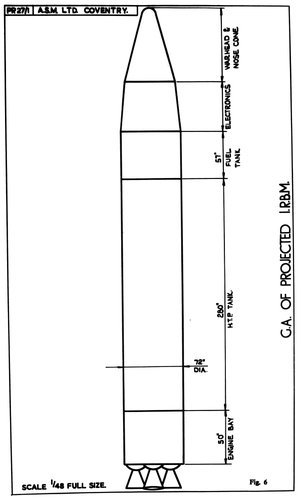I remember as a school child in Australia listening on the radio from the ABC the live telecast of the Blue Streak launch from Woomera. The announcer was quite tense and when the second stage failed to launch, he was quite quiet for a few moments and then the teacher turned the radio off. It was quite a day in the schoolroom. I knew I had witnessed the death of a rocket system.
Perhaps the announcer was confused. The sorry history of the ELDO upper stages did not include a second stage failure.
Blue Streak was cancelled as a weapon in April 1960. To salvage something from the £60-80 million already spent and minimise political embarrassment it was proposed to use the rocket as the first stage of a satellite launching system called Black Prince, which used Blue Streak as the first stage and Black Knight as the second. A dribble of funding was provided to keep the project alive but the two rockets did not form an ideal combination, which together with the cost of Black Prince, gave the British Government second thoughts and led them to propose a European collaborative project instead. This led to the formation of the European Launcher Development Organisation, ELDO, and the Europa Launch System which comprised Blue Streak as the first stage carrying ‘Coralie’, which was a French second stage; ‘Astris’, which was a German third stage; and, initially, Italian satellites. Activity increased greatly with ELDO funding to a peak in 1964 but there was progressive falling out between the partners over development policy and authority coupled with total lack of enthusiasm among British politicians and civil servants. In that year the new Labour government of Harold Wilson set up the Department of Economic Affairs to counterbalance the Treasury and the DEA was opposed to space engineering activity in any form. Just one DEA quote combines ignorance and prejudice beautifully. “There may possibly be a long-term interest in TV transmission by satellite but this is never likely to be economic”! A period of delay, underfunding, bad advice and desultory activity would follow before complete failure of political will in the UK led to withdrawal from ELDO. The Europa programme was abandoned on 27 April 1973. Blue Streak had already made its last flight in 1971.
Blue Streak flight history is worth summarising.
F1 was fired from WRE Woomera on 5 June 1964. The flight was faultless for 145 seconds of the 154 second planned burn time. At that point residual fuel sloshing in the tanks became so severe that the control system limits were exceeded and the vehicle tumbled out of control shutting off the engines through fuel starvation. The problem had been anticipated but left unresolved so that the flight would provide adequate data to make the necessary increase in autopilot sensitivity. This was done successfully and the fault did not recur.
F2 was fired on 20 October 1964 and was completely successful.
F3 was fired on 22 March 1965 and was completely successful.
F4 was fired successfully on 24 May1966 carrying dummy upper stages.
F5 was fired successfully on15 November 1966 carrying dummy upper stages.
F6 was fired successfully on 4 August1967 with a live second stage
F7/1 was fired successfully on 5 December 1967 with a live second stage.
F7/2 was fired successfully on 30 November 1968. All stages live. Third stage (German) exploded.
F8 was fired successfully on 31 July 1969. All stages live. Third stage exploded.
F9 was fired successfully on 11 June 1970 All stages live. Fairings (Italian) did not separate.
F10 was not fired for budgetary reasons. (The money ran out!)
F11 was fired from Kourou in French Guyana on 5November 1971 in an attempted satellite launch. Static discharges caused by friction with the air caused the third stage guidance system to fail after separation. The vehicle went out of control and broke up. Blue Streak performance was once again faultless.
Once the autopilot sensitivity that F1 had shown to be necessary was incorporated, every subsequent Blue Streak performance, that is to say in ten flights out of the eleven, was faultless.
Rickshaw did not witness the death of a rocket system. It had alreadybeen sentenced to a lingering death in Whitehall years before.

